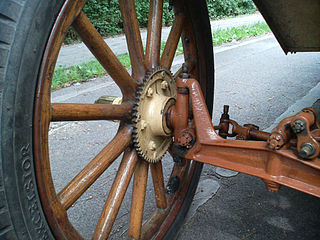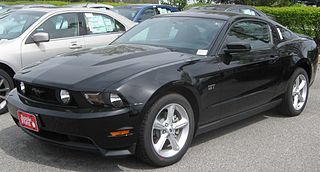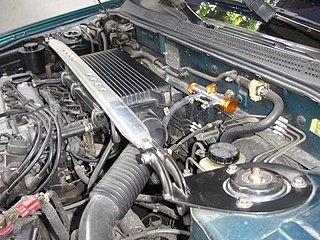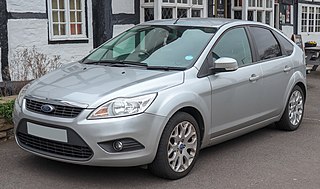RevoKnuckle is a variation of the MacPherson strut suspension design by Ford which separates steering and suspension movements to provide lower scrub radius [1] and kingpin offset than traditional MacPherson struts.
RevoKnuckle is a variation of the MacPherson strut suspension design by Ford which separates steering and suspension movements to provide lower scrub radius [1] and kingpin offset than traditional MacPherson struts.
Ford claims that it weighs less and costs less than double wishbone and multi-link suspension arrangement. The kingpin offset compares favorably to that of double wishbone suspensions (20-30mm vs 40mm). The main advantage of RevoKnuckle compared to MacPherson struts is the reduction in torque steer, especially for high powered front-wheel drive (FWD) applications.
The RevoKnuckle is intended for use on FWD platforms such as the Focus, Mondeo, and was used in the RS Mk2 version of the Ford Focus.

Camber angle is one of the angles made by the wheels of a vehicle; specifically, it is the angle between the vertical axis of a wheel and the vertical axis of the vehicle when viewed from the front or rear. It is used in the creation of steering and suspension. If the top of the wheel is farther out than the bottom, it is called positive camber; if the bottom of the wheel is farther out than the top, it is called negative camber.

The MacPherson strut is a type of automotive suspension system that uses the top of a telescopic damper as the upper steering pivot. It is widely used in the front suspension of modern vehicles. The name comes from American automotive engineer Earle S. MacPherson, who invented and developed the design.

The kingpin is the main pivot in the steering mechanism of a car or other vehicle.

A strut is a structural component commonly found in engineering, aeronautics, architecture and anatomy. Struts generally work by resisting longitudinal compression, but they may also serve in tension.

Independent suspension is any automobile suspension system that allows each wheel on the same axle to move vertically independently of the others. This is contrasted with a beam axle or deDion axle system in which the wheels are linked. "Independent" refers to the motion or path of movement of the wheels or suspension. It is common for the left and right sides of the suspension to be connected with anti-roll bars or other such mechanisms. The anti-roll bar ties the left and right suspension spring rates together but does not tie their motion together.

The Ford D2C platform is one of Ford's rear-wheel drive automobile platforms.

A double wishbone suspension is an independent suspension design for automobiles using two wishbone-shaped arms to locate the wheel. Each wishbone or arm has two mounting points to the chassis and one joint at the knuckle. The shock absorber and coil spring mount to the wishbones to control vertical movement. Double wishbone designs allow the engineer to carefully control the motion of the wheel throughout suspension travel, controlling such parameters as camber angle, caster angle, toe pattern, roll center height, scrub radius, scuff, and more.

The Chapman strut is a design of independent rear suspension used for light cars, particularly sports and racing cars. It takes its name from, and is best known for its use by, Colin Chapman of Lotus.

In automotive suspension, a control arm, also known as an A-arm, is a hinged suspension link between the chassis and the suspension upright or hub that carries the wheel. In simple terms, it governs a wheel's vertical travel, allowing it to move up or down when driving over bumps, into potholes, or otherwise reacting to the irregularities of a road surface. Most control arms form the lower link of a suspension. Control arms play a crucial role in the suspension system of a vehicle. They help to keep the wheels aligned and maintain proper tire contact with the road, which is essential for safety and stability.
Torque steer is the unintended influence of engine torque on the steering, especially in front-wheel-drive vehicles. For example, during heavy acceleration, the steering may pull to one side, which may be disturbing to the driver. The effect is manifested either as a tugging sensation in the steering wheel, or a veering of the vehicle from the intended path. Torque steer is directly related to differences in the forces in the contact patches of the left and right drive wheels. The effect becomes more evident when high torques are applied to the drive wheels because of a high overall reduction ratio between the engine and wheels, high engine torque, or some combination of the two. Torque steer is distinct from steering kickback.

A strut bar, strut brace, or strut tower brace (STB) is an automotive suspension accessory on a monocoque or unibody chassis to provide extra stiffness between the strut towers.

In an automobile, ball joints are spherical bearings that connect the control arms to the steering knuckles, and are used on virtually every automobile made. They bionically resemble the ball-and-socket joints found in most tetrapod animals.
A dual ball joint suspension uses a pair of arms, one in tension, one in compression, to replace a wishbone, in a MacPherson or SLA suspension. The outer end of each arm terminates in a ball joint, hence the name.
The scrub radius is the distance in front view between the king pin axis and the center of the contact patch of the wheel, where both would theoretically touch the road. It can be positive, negative or zero.
Automotive suspension design is an aspect of automotive engineering, concerned with designing the suspension for cars and trucks. Suspension design for other vehicles is similar, though the process may not be as well established.

Haynes Roadster is a replica of a Lotus Seven home-built car, according to a book Build Your Own Sports Car: On a Budget by Chris Gibbs (ISBN 1-84425-391-0). A Ford Sierra is used in the car as a donor for drivetrain and suspension components.

Twin-Traction Beam (TTB) is an independent suspension system for front drive axles in four-wheel drive Ford F-Series trucks and sport utility vehicles.

The Ford Focus Mk 2 is the second generation of Ford Focus, a range of small family cars produced by Ford Motor Company from 2005 to 2010. It was launched at the Paris Motor Show on September 25, 2004, as a three and five-door hatchback and an estate, although the new car was previewed, in 4-door saloon form, as the 'Focus Concept' developed by Ford Europe at the Beijing Motor Show in mid-2005.
Dual-pivot steering geometry is a geometric arrangement of linkages in the steering of a car designed to reduce or eliminate scrub radius by moving the pivot point of the king pin outboard, in order to improve steering precision and straight line stability.
Pull-rod suspension and push-rod suspension refer to a specialised type of automotive suspension system which is largely based on a double-wishbone system, incorporating elements of the commonly used MacPherson strut.